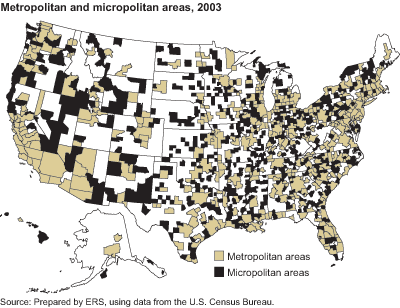Behind the Data
- Contact: Website Administrator
- 9/1/2003
Defining Rural Areas Based on New County Classifications
- Analysts and policymakers who refer to “rural” America are often referring to nonmetropolitan (nonmetro) areas. In conjunction with Census 2000, the Office of Management and Budget (OMB) has made far-reaching changes to the classification system it uses to define nonmetro and metro areas, simplifying criteria that determine status and adding a new “micropolitan” classification (see box). Up until now, nonmetro territory was undifferentiated; the new micropolitan (micro) category subdivides nonmetro areas into two distinct types of counties. This change may help target rural-based programs to those areas most in need.
- Under the previous system, areas were classified as metro if they included central counties with one or more cities of at least 50,000 residents or urbanized areas of 50,000 or more residents and total area population of at least 100,000. Outlying counties were classified as metro if they were economically tied to the central counties, as measured by daily commuting to work, and displayed a level of “metropolitan character” based on population density, urbanization, and population growth.
- Under the new “core-based statistical area” system, metro areas include central counties with urbanized areas of 50,000 or more residents, regardless of total area population. In addition, the classification includes outlying counties with commuting thresholds of 25 percent, with no metropolitan character requirement. Streamlining the criteria in this manner results in approximately 2 million fewer residents covered by metro areas. However, actual expansion of metro territory during the 1990s added 9 million persons. The net effect reduces the 2000 nonmetro population from 56 million to 49 million.
- Micro areas include central counties with one or more urban clusters of 10,000-50,000 persons. As with metro area designations, outlying counties are classified as micro if commuting levels are 25 percent or higher. Because they are county-based and include outlying counties, micro areas can have total area populations that reach well beyond 50,000. The inaugural set of 560 micro areas includes 674 counties and range in size from 13,000 (Andrews, TX) to 182,000 (Torrington, CT).
- Of the 49 million nonmetro residents counted in Census 2000, 29 million live in micro areas. The remaining 20 million nonmetro residents live in 1,383 “noncore” counties, which lack urban clusters of 10,000 or more residents. In general, lack of an urban core and low overall population density may place these counties at a disadvantage in efforts to expand and diversify their economic base. However, the population in noncore counties grew by 7.9 percent during the 1990s, compared with a growth rate of 9.9 percent in micro areas and 14 percent in metro areas.
This article is drawn from:
- Rural Classifications. (n.d.). U.S. Department of Agriculture, Economic Research Service.


